Barely 18 months ago chip manufacturer Intel released the latest “Tock” in its “Tick Tock”-strategy. The changes it brought includes the today well-known Nehalem and Bloomfield architectures. With four cores and two threads per core most enthusiasts with the money to spend were satisfied with the performance offered. The CPU’s were packaged for the 1366 socket, which means a fairly expensive solution with Intel’s X58 chipset as the only alternative and three DDR3 channels. At launch the flagship was Core i7 965, today everything changes.

As many of you know, “Tock” means a transition to a new architecture, whilst “Tick” means shrinking the manufacturing process and minor optimizations, such as added instructions and more cache memory. Intel has however already released a minor tick of the 32nm architecture with the Clarkdale, but today one of the world’s worst kept secrets is finally introduced in the shape of Intel Core i7 980X – the first hexa core CPU for the home users.
Overall most things look the same, Core i7 980X is a CPU for Socket 1366, just like the rest of the Core i7 900 series. This means you have to pair your all new processor with an 18 months old chipset in the form of X58. The positive is that the only thing you need to get a Core i7 980X, code-named Gulftown, to work with your X58 motherboard is a BIOS update. The successor, X68, is coming, but when and what it will bring is a bit foggy.
A short history on socket LGA1366 can be found below to refresh your memories.

Everything looks the same on the chipset side of things, as expected, but with the CPU there are some major differences. The most impressive is the number of transistors that has increased by 400 million to 1.17 billion, in spite of that the die is actually the smallest of all high-end alternatives on the market with 248 square millimeters, all thanks to the 32nm process. That i7 980X is a bit “hotter” than the competition shouldn’t come as a shock for anyone, the specifications are impressive and listed below.
|
i7-980X
|
i7-975
|
i7-870
|
Phenom II 965
|
|
|---|---|---|---|---|
| Manufacturing Proc. | 32nm | 45nm | 45nm | 45nm |
| Transistors | 1170M | 731M | 774M | 758M |
| Die size | 248mm2 | 263mm2 | 296mm2 | 258mm2 |
| Cores (phys./logic) | 6/12 | 4/8 | 4/8 | 4/4 |
| Cache | 12MB | 8MB | 8MB | 6MB |
| Frequency | 3.33GHz | 3.33GHz | 2.93GHz | 3.4GHz |
| TDP | 130W | 130W | 95W | 125W |
| Socket | LGA1366 | LGA1366 | LGA1156 | Socket AM3 |
| MSRP | $999 | $999 | $540 | $190 |
Core i7 980X places itself as the new cock of the walk, replacing Core i7 975, with a recommended street price of $999. This is the ordinary price for Intel’s latest high-end-CPUs, in the future we hope to see cheaper version based on the Gulftown core. The CPU is branded Extreme Edition, with all that it brings if you happened to miss that. This means that you, just like you had with Core i7 965 and 975, have full control over all multipliers, the bus frequency multiplier is very interesting, not the least when most LGA1366 motherboards get stubborn around 230MHz Base Clock. All of this makes Gulftown an excellent candidate for overclocking, which is something we will return to later on.
To get back to the archtiecture we have some nice picture of Gulftown’s design below.
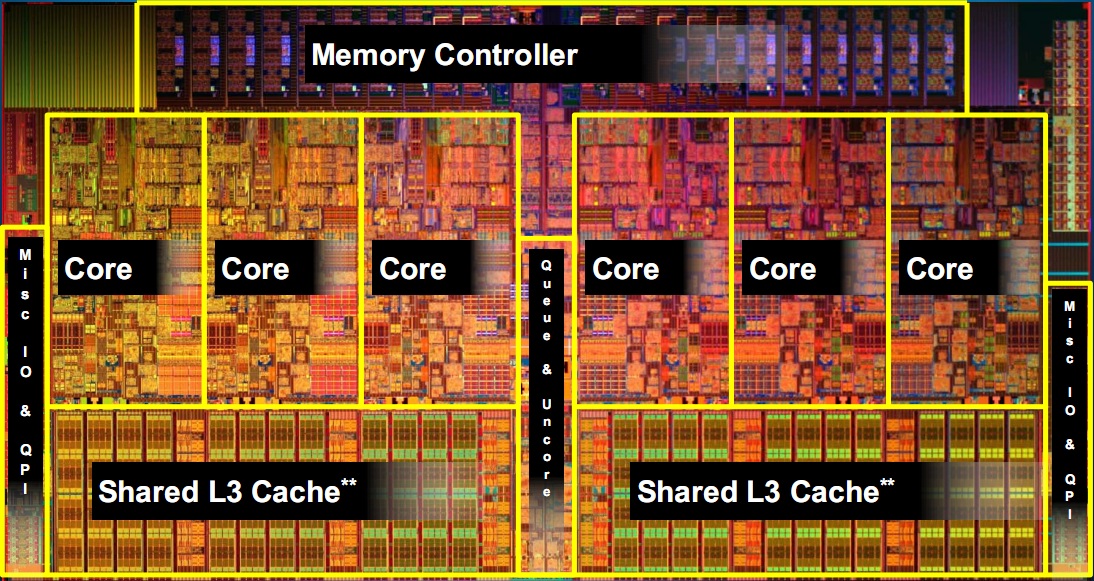
Core i7 980X parts – Click to enlarge
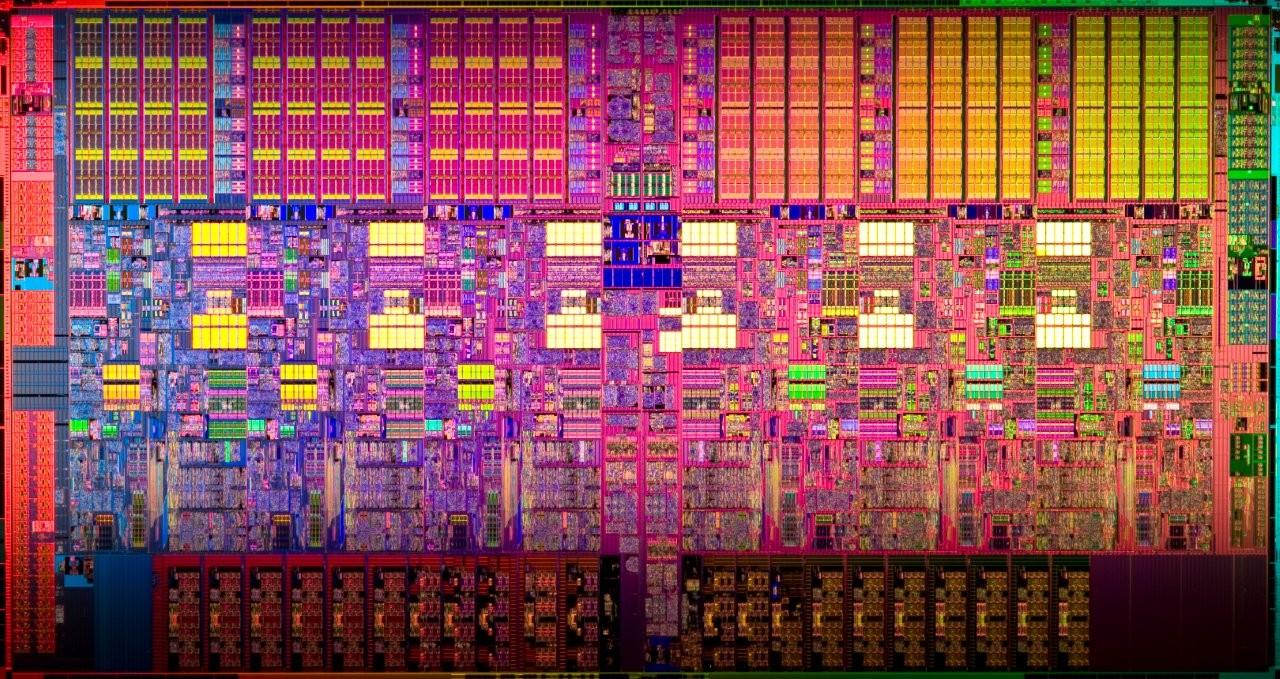
Click to enlarge

Click to enlarge
The first thing that strikes you when you get an Intel Core i7 980X is the box, it’s huge. We only had a so called “whitebox”, which is a replica of the original box but no graphics. We’re wondering though why Intel bundles a cooler when the processor is obviously designed for hardcore enthusiasts who are just going to throw it away.

Core i7 980X inside a small forest – retail box
After chopping through a minor rain forest to get through the side of the box, thrown the cooler aside and ripped out the processor you are greeted by the following sight, although hopefully without the “Intel Confidential” branding indicating that this is an Engineering Sample. Q4EG Indicate that this is B1 stepping, which is the same as retail.

Intel Core i7 980X Extreme Edition
The CPU aside there was a cooler in the box, called DBX-B and it is actually quite beefy for being an Intel cooler. It sports a PWM controlled fan with two modes (Quiet and Performance), four heatpipes and a very simple installation using thumb screws and bundled backplate.
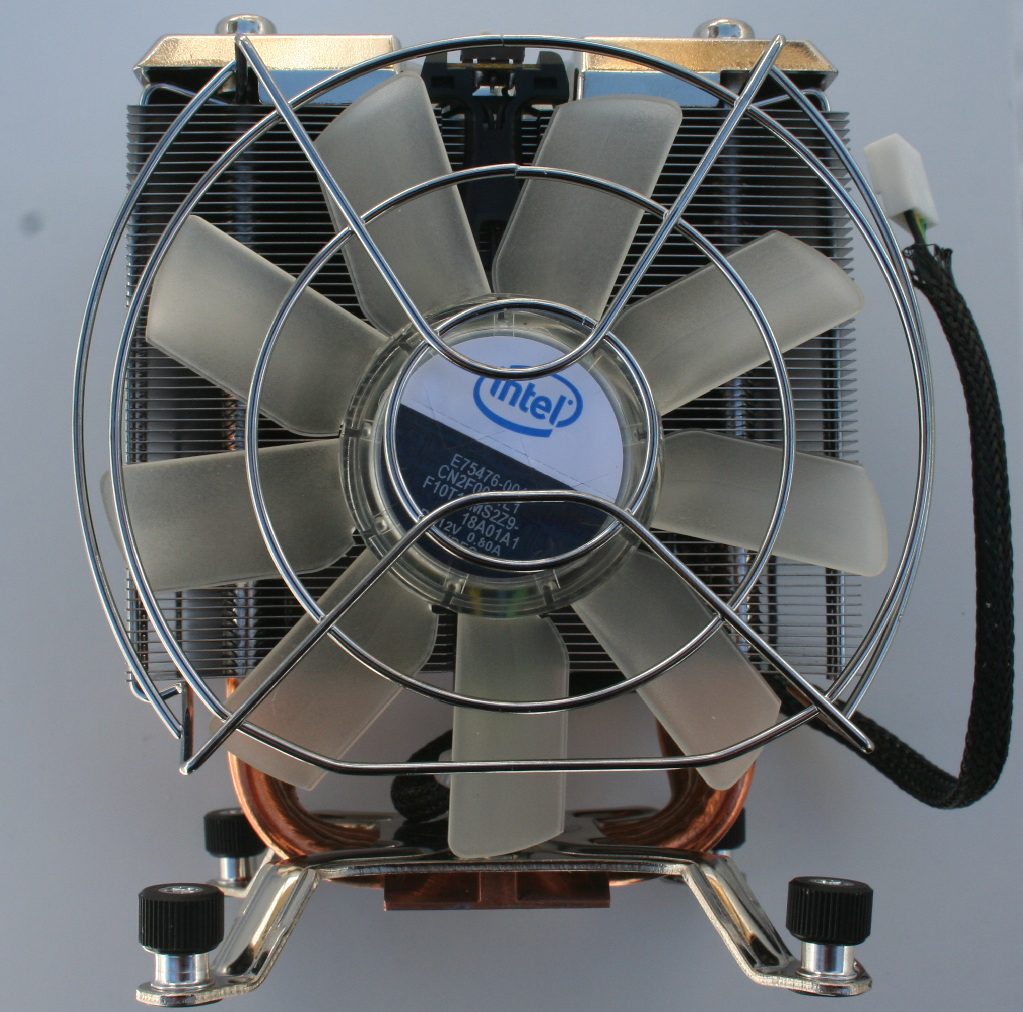
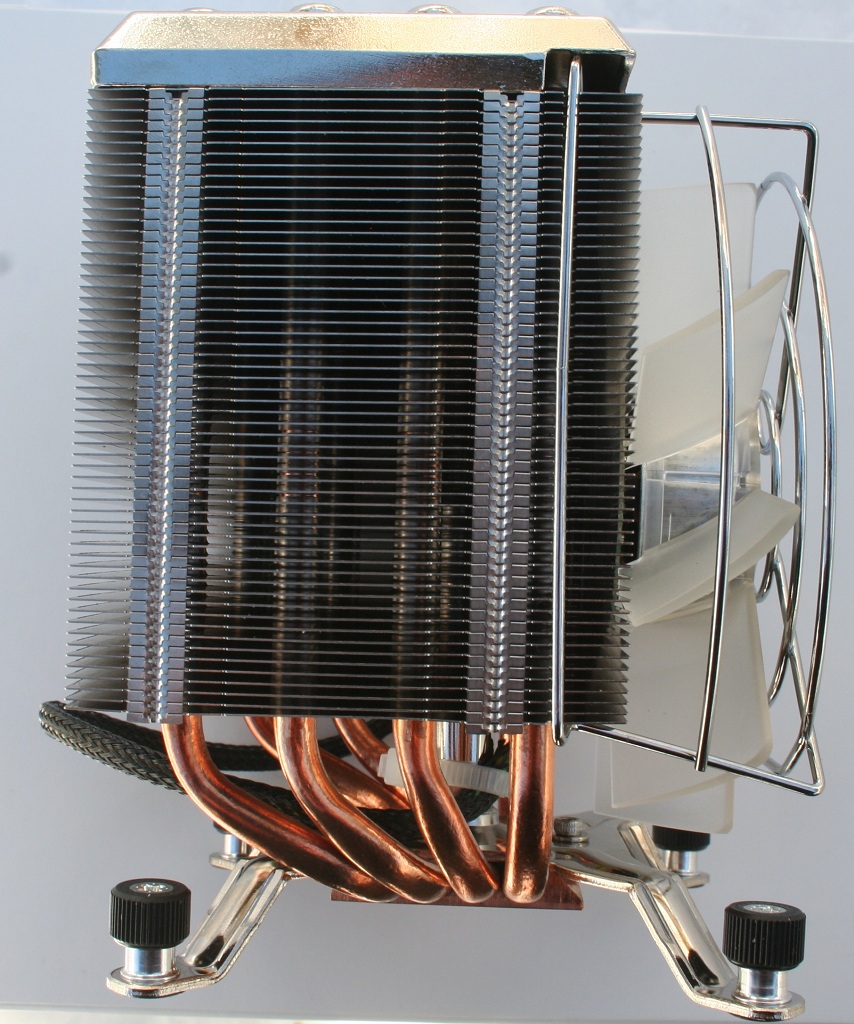
|
||
|---|---|---|
| Motherboard | ASUS Rampage III Extreme ASUS Maximus III Extreme ASUS Crosshair III Formula |
|
| Processor | Intel Core i7-980X Intel Core i7-975 AMD Phenom II 965 |
|
| Memory | Corsair TR3X6G1866C9D @1866MHz (X58) Corsair TR3X6G1866C9D @1600MHz (P55/AM3) |
|
| Graphics card | XFX Radeon HD 5870 | |
| Harddrive | OCZ Summit 60GB | |
| Operating system | Windows 7 Ultimate 64-bit | |
| Benchmarks | 3DMark 06 3DMark Vantage Cinebench 11.5 Dirt 2 Everest Ultimate v5.30 POV-Ray 3.7b35a Street Fighter IV SuperPI 1.5 WinRAR 3.92 wPrime 1.55 |
|
Overclocking a new CPU is always interesting, especially since we’ve seen what Intel’s 32nm architecture is capable of in the form of Clarkdale. The manufacturing process seems to lack any kind of coldbugs, which is very helpful when you’re overclocking with sub-zero cooling, since the silicon usually performs better with lower temperatures.
We’re quite not there yet, since we didn’t get our sample of Core i7 980X until Tuesday afternoon ( about 38 hours ago), instead we have had to focus on completing a review in this time, but we haven’t neglected the overclocking bit entirely, since we would consider it to be a general failure on our part. Instead we spent some time finding the highest stable frequency for all of our benchmarks found on the following pages. We concluded that 4.4GHz was a stable frequency with 1.425V, which worked perfectly with the bundled cooler, which is most likely not the cooler people will settle for. Tasty treats below.

4405.7MHz – a stable frequency with the bundled cooler
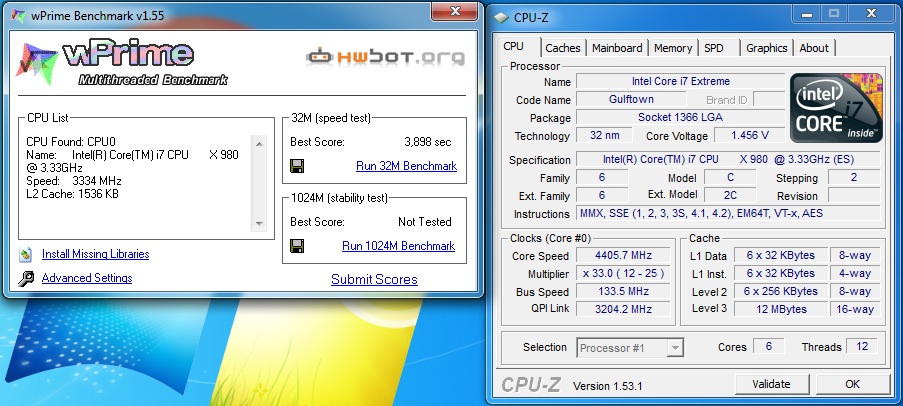
3.898s in wPrime 32M – A result of 12 threads and high clock frequency
Hitting 4.4GHz with 12 threads active with only air cooling from some very quick overclocking tests is pretty impressive to us. We have seen over 5GHz with water cooling for a CPU-Z “kill screen”, which doesn’t really say that much in all honesty. We look forward to mounting our LN2 pot on the processor as soon as possible, but now it’s time to run some of our benchmarks where the 4.4GHz-overclocking is available in every graph.
As usual we have included Futuremark’s benchmark suites, in the form of PCMark 05 and its CPU test suit. First we have 3DMark Vantage, where we have included the total score and the CPU test.
| 3DMark Vantage Performance Preset [p] |
|||||||||||||||||||||||||||||||||||||
|
|||||||||||||||||||||||||||||||||||||
|
|||||||||||||||||||||||||||||||||||||
| 3DMark Vantage CPU Score [p] |
|||||||||||||||||||||||||||||||||||||
|
|||||||||||||||||||||||||||||||||||||
|
|||||||||||||||||||||||||||||||||||||
That 3DMark Vantage takes advantage of multiple is quite obvious in the CPU tests, but it also pulverizes the opposition in the regular test. 3DMark 06 follows.
| 3DMark 06 1280×1024 [p] |
|||||||||||||||||||||||||||||||||||||
|
|||||||||||||||||||||||||||||||||||||
|
|||||||||||||||||||||||||||||||||||||
| 3DMark 06 CPU test [p] |
|||||||||||||||||||||||||||||||||||||
|
|||||||||||||||||||||||||||||||||||||
|
|||||||||||||||||||||||||||||||||||||
The elderly edition doesn’t scale as well with more threads like Vantage, but still noticeably in the CPU test. Especially the overclocked version runs ahead since the CPU test weighs in more with 3DMark 06.
| PCMark 05 CPU Suite [p] |
|||||||||||||||||||||||||||||||||||||
|
|||||||||||||||||||||||||||||||||||||
|
|||||||||||||||||||||||||||||||||||||
PCMark 05 isn’t exactly new to the scene, but the CPU tests is intended to simulate normal use, which is why we included it. PCMark 05 behaves much like 3DMark 06; it doesn’t scale beyond four threads, but clock frequency has a major impact on the score. Core i7 980X performs better than the precursor Core i7 975 where not all threads are used, which is relatively logical since these tests are pretty cache intensive.
On the following page we dive into the multithreaded world with Everest Ultimate.
To see what the six core in Core i7 980X can do we have turned to Everest, where the CPU tests are overall well optimized for multithreaded CPUs, which should be result in an easy win in most benchmarks here. Let’s have a look.
| Everest Ultimate CPU Queen [p] |
|||||||||||||||||||||||||||||||||||||
|
|||||||||||||||||||||||||||||||||||||
|
|||||||||||||||||||||||||||||||||||||
| Everest Ultimate CPU ZLib [kB/s] |
|||||||||||||||||||||||||||||||||||||
|
|||||||||||||||||||||||||||||||||||||
|
|||||||||||||||||||||||||||||||||||||
| Everest Ultimate FPU Mandel [p] |
|||||||||||||||||||||||||||||||||||||
|
|||||||||||||||||||||||||||||||||||||
|
|||||||||||||||||||||||||||||||||||||
| Everest Ultimate FPU SinJulia [p] |
|||||||||||||||||||||||||||||||||||||
|
|||||||||||||||||||||||||||||||||||||
|
|||||||||||||||||||||||||||||||||||||
Core i7 980X do a clean sweep in these synthetic CPU tests, the question is what the memory performance is like. Is there anything new to find out?
| Everest Ultimate Mem Read [MB/s] |
|||||||||||||||||||||||||||||||||||||
|
|||||||||||||||||||||||||||||||||||||
|
|||||||||||||||||||||||||||||||||||||
| Everest Ultimate Mem Latency [ns] |
|||||||||||||||||||||||||||||||||||||
|
|||||||||||||||||||||||||||||||||||||
|
|||||||||||||||||||||||||||||||||||||
If the memory benchmarks are 100% reliable is hard to say, but most likely they are a bit off since our version of Everest isn’t optimized for Gulftown. At the same memory frequency (1866MHz CL9) as i7 975 Core i7 980X is at least as fast as its precursor. We will return to these tests when Lavalys releases a new version optimized for Gulftown.
It’s pretty obvious by now that Intel has done a top notch job with improving, shrinking and adding two cores to the Core i7 architecture. Let’s move on to some more benchmarks that should reveal if there is a problem with the memory controller or if Everest is misleading us.
SuperPI and wPrime are two programs that may not be the first two that the average user turn to every day, but the fact is that both are intensive for the CPU and memory controller, and very sensitive to bandwidth changes. The latter of the two is also optimized for multithreading. Results below.
| SuperPI 1M [s] |
|||||||||||||||||||||||||||||||||||||
|
|||||||||||||||||||||||||||||||||||||
|
|||||||||||||||||||||||||||||||||||||
| wPrime 32M [s] |
|||||||||||||||||||||||||||||||||||||
|
|||||||||||||||||||||||||||||||||||||
|
|||||||||||||||||||||||||||||||||||||
| wPrime 1024M [s] |
|||||||||||||||||||||||||||||||||||||
|
|||||||||||||||||||||||||||||||||||||
|
|||||||||||||||||||||||||||||||||||||
The efficiency of SuperPI 1M is a bit wobbly, perhaps the memory controller of 980X is less efficient than 975, and that Core i7 870 managed to squeeze in between them was a bit of a mishap. AMD is horribly optimized for SuperPI, no secret on the other hand, and the reason the green camp is left behind in wPrime is simply because it only uses four threads, one per core, while Intel lines up two. Sex cores and twelve threads is massive with wPrime, not to mention the advantages of the overclocking. For example, Core i7 975 with eight threads at 5GHz results in around 5s with wPrime 32M, which is still too slow to beat 980X at stock frequency. Impressive.
POV-Ray, WinRAR and Cinebench all fall into the category “practical benchmarks”, I.e. simulations of actual every day work loads.
POV-Ray is a program for ray-tracing, something Intel made a lot of fuss about a while back when boasting the Larrabee chip. The application simply measures how efficiently your CPU renders pixels and the result is measured in Pixels Per Second, the program can take advantage of multi-threaded CPUs.
| POV-Ray Multithread Benchmark [PPS] |
|||||||||||||||||||||||||||||||||||||
|
|||||||||||||||||||||||||||||||||||||
|
|||||||||||||||||||||||||||||||||||||
With the power of more cores Core i7 980X takes home POV-Ray without stressing too much. Will the scenario repeat itself in WinRAR?
| WinRAR File Benchmark [kB/s] |
|||||||||||||||||||||||||||||||||||||
|
|||||||||||||||||||||||||||||||||||||
|
|||||||||||||||||||||||||||||||||||||
WinRAR takes advantage of multithreaded CPUs and the result shows it. Core i7 980X has a lead over Core i7 975, although not huge.
Moving on to our last CPU test, namely the latest edition of Cinebench, 11.5. The most interesting bit about Cinebench is that it calculates how performance scales with more threads, as well as efficiency per thread.
| Cinebench 11.5 Single-Core [p] |
|||||||||||||||||||||||||||||||||||||
|
|||||||||||||||||||||||||||||||||||||
|
|||||||||||||||||||||||||||||||||||||
| Cinebench 11.5 Multi-Core [p] |
|||||||||||||||||||||||||||||||||||||
|
|||||||||||||||||||||||||||||||||||||
|
|||||||||||||||||||||||||||||||||||||
| Cinebench 11.5 CPU scaling [x] |
|||||||||||||||||||||||||||||||||||||
|
|||||||||||||||||||||||||||||||||||||
|
|||||||||||||||||||||||||||||||||||||
That Core i7 980X doesn’t scale up to 12x shouldn’t come as a surprise to you since there is really just six physical cores, HyperThreading helps to go above 6x scaling. The scaling is very much alike that of Core i7 975, even though it has two cores and four threads more – once again very good. That the CPU is slower in single-threaded tests seems to be the generic trend, although the difference is marginal. This can be remedied with some overclocking, which our benchmarks have shown pretty clearly.
Let’s close with some game benchmarks.
Today’s game suit is pretty limited, it has only two titles: first Street Fighter at 1280×720, to make the CPUs stress, then Dirt 2 at 1920×1080, mainly because the game refused to work at any other resolution. The result were as you can see below, especially the case of Street Fighter is somewhat CPU limited, since the game isn’t very CPU intensive.
| Street Fighter IV 1280×720 [fps] |
|||||||||||||||||||||||||||||||||||||
|
|||||||||||||||||||||||||||||||||||||
|
|||||||||||||||||||||||||||||||||||||
| Dirt 2 1920×1080 [fps] |
|||||||||||||||||||||||||||||||||||||
|
|||||||||||||||||||||||||||||||||||||
|
|||||||||||||||||||||||||||||||||||||
As it turns out Street Fighter doesn’t care about multithreaded CPUs, which may not come as a surprise considering how light it is overall. Dirt 2 å on the other hand gives AMD its only victory for the day, but you should remember that the game was developed together with AMD. It’s a bit curious to see that 980X was actually the worst contender in this benchmark, which can’t really explain. Most likely the code masters at Codemasters failed to master the code.
This was the last of the benchmarks, on the next page we have the power consumption data.
To test the power consumption we chose to test the idle consumption first, I.e. when doing nothing and just having the Windows desktop before us. Load, the consumption during heavy work, is measured during a round of wPrime. All numbers are for the entire system, even if only the CPU is loaded. The Power is measured using a wall plug watt meter from Clas Ohlson, which means the numbers are not exact but more relative to each other.
| Power consumption Idle [W] |
|||||||||||||||||||||||||||||||||||||
|
|||||||||||||||||||||||||||||||||||||
|
|||||||||||||||||||||||||||||||||||||
| Power consumption Load [W] |
|||||||||||||||||||||||||||||||||||||
|
|||||||||||||||||||||||||||||||||||||
|
|||||||||||||||||||||||||||||||||||||
That i7 980X consumes 22W more under load than all the cores of i7 975 even though they share the same TDP feels a bit odd, but this is the results we get after repeated tests. Overclocking usually makes the TDP skyrocket and increase by massive 74W at 4.4GHz with 1.425V compared to stock frequency and voltage. Unfortunately we don’t have any temperature data to share at this time, but subjectively speaking the new hexa-core 980X CPU does feel cool and easy keep the temperatures down, much thanks to the 32nm manufacturing process.
Intel is executing its tick-tock strategy step by step and it has been a winning concept so far. Claiming that AMD is near Intel’s performance is exaggerating no matter how you look at it, which is a real shame for those of us who are looking for a new CPU. Ironically we recently witnessed how a AMD used its position as the dominator on the graphics card market and hiked the prices. If AMD had put up a better fight Intel might have offered more than just one hexa.core CPU, but without any real competition there is no real reason to do so. Instead it can package its new processors in black boxes and cash in while the competition tries to catch up.
We won’t go on and on about that though, but instead turn our attention to Intel Core i7 980X and conclude that the performance in multi-threaded applications is very impressive and unbeatable today. Worst case scenario it ties with the precursor Core i7 975, which is nothing to be ashamed of or even think much about, since the clock frequencies are the same and the only thing that has really happened is that two cores have been added along with some cache, and shrunk the gate width to 32nm.
On top of that Intel knows that no one wants to buy a processor for almost $1000 to realize that the bundled cooler sucks – DBX-B remedies this and is actually pretty decent. Okey, we admit, we haven’t had the time to check the temperatures more exact, but the cooler isn’t all bad if it can keep six cores stable at 4.4GHz. At the same time one can’t help thinking about who might consider using this cooler for this very expensive piece of machinery – we’re hoping that DBX-B will be bundled with future Intel CPUs no matter the price. it may be a bit loud if you don’t try to tweak the PW settings in BIOS, but still a more than OK cooler all things considered.
Speaking of temperatures we can announce that Core i7 980X lacks coldbug and scales with cooling all the way, count on 6GHz results from us soon with the help of some liquid nitrogen. Seen from a regular consumer’s perspective this processor might be too much, especially with the price in mind, nearly $1000, but to us this is just the start of an overclocking feast.
 Intel Core i7 980X is the currently fastest processor on the market and for the extreme users or for that matter workstations there is no equivalent in terms of performance. It has never been easier to award a product our esteemed performance award and even if the price tag is extreme it is the first time we get some added value with Intel’s Extreme Edition models, 50% more cores and occasionally better performance than all other models on the market.
Intel Core i7 980X is the currently fastest processor on the market and for the extreme users or for that matter workstations there is no equivalent in terms of performance. It has never been easier to award a product our esteemed performance award and even if the price tag is extreme it is the first time we get some added value with Intel’s Extreme Edition models, 50% more cores and occasionally better performance than all other models on the market.
This not only makes us want more hexa-core models from Intel but also more efficient multi-threading in games and applications to make sure these processors really come to good use.
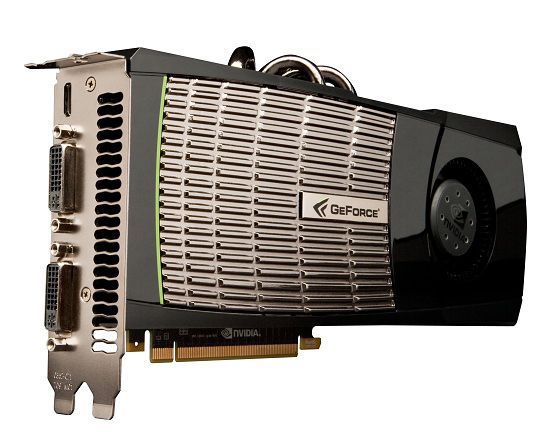 |
|
|
Pros Cons |
|
We want to thank Intel for sending us this 980X for evaluation.
















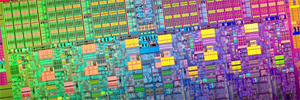
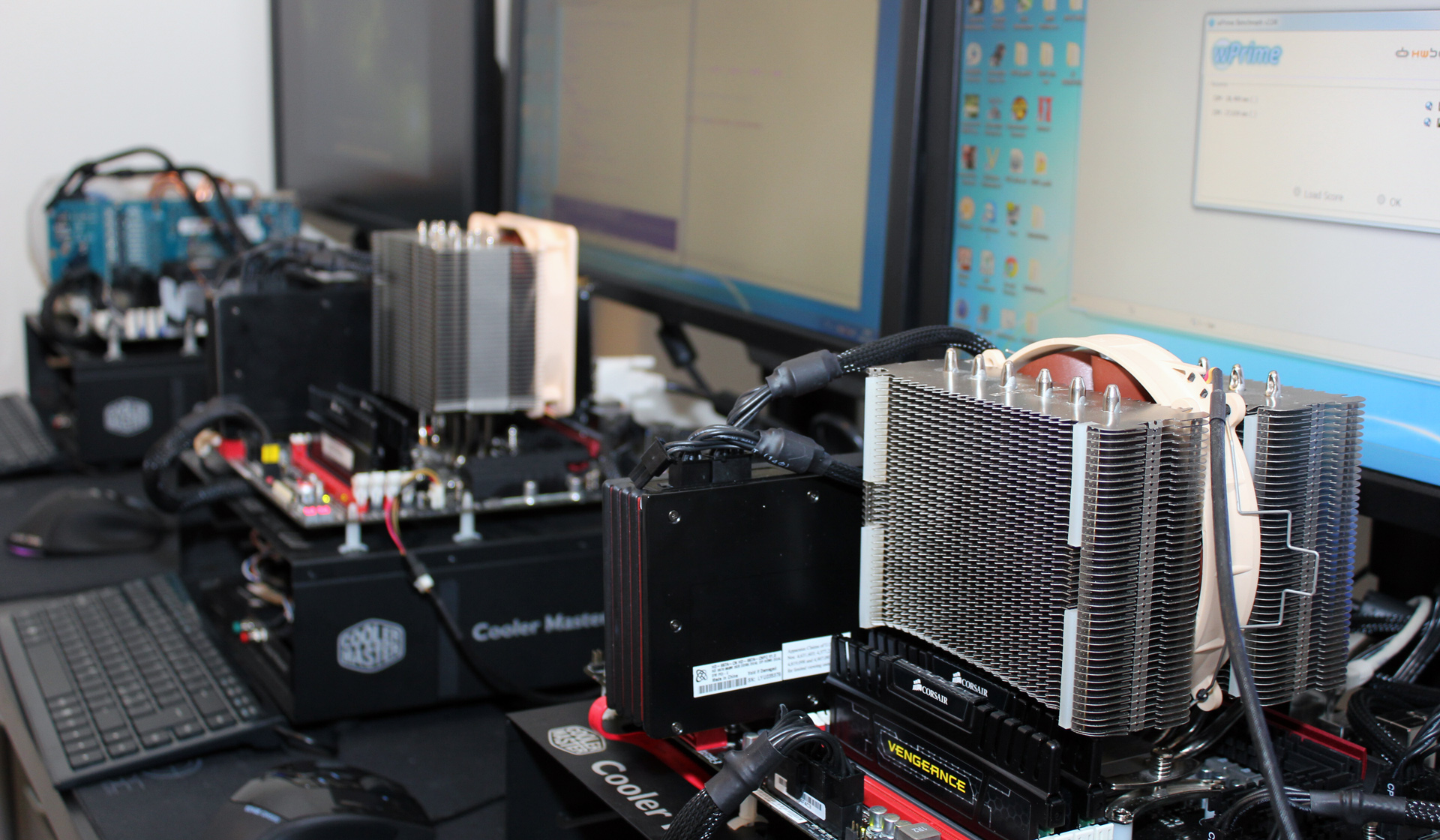






I demand LN2 overclocking results!
It’s amazing how they manage to fit two more physical cores on the die yet only use 4w more at idle than it’s quad core brethren. Die shrinks are a beautiful thing.